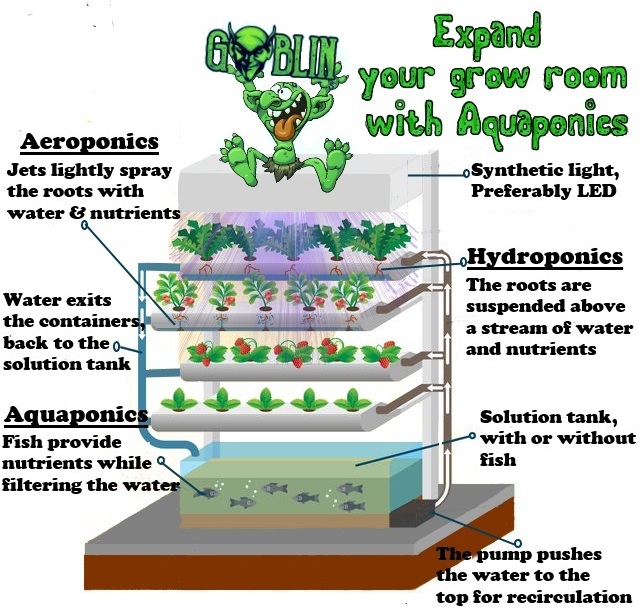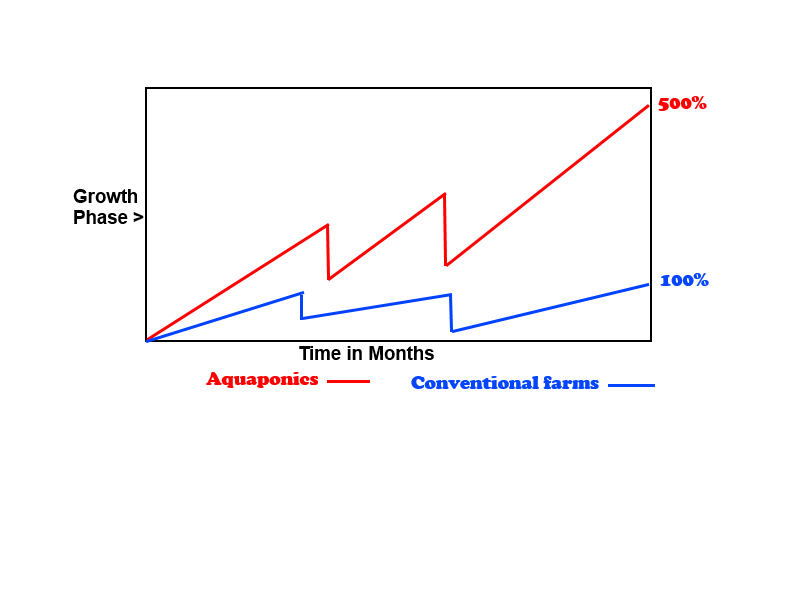As we rush towards a greener tomorrow, techniques that have been given to us by mother nature are being revived with modern methods. Aquaponics has a long way to go but both economically and environmentally speaking, this path with have many rewards.
Top Article from 2019 - Convert Your Hydroponic System to an Aquaponic System
Contributed by | GoblinHydro
For those of you who are seasoned growers, aquaponics might be an investment worth while. Aquaponics is all about your water and nutrients in your solution tank, so your not really "converting" as much as you are "adding." it doesn't matter how you choose to deliver water and nutrients to your plant, as long as it comes from the tank inhabited by the fish. Everything you have set up, however it is laid out, you're just a couple steps away from converting your hydroponic or aeroponic system to a aquaponic system.

Aside from the many benefits you will read below, teachers have been turning to hands on education using small aquaponic systems in the classroom.
Why convert?
Yes, it may require a little bit of extra capital, but the benefits far exceed the cost. Organic matter contained in fish feces and feed are used for the conversion of fish generated ammonia to nitrate. Bacteria breaks down the fish waste and converts it to plant food and nutrients. This is a huge cut in your nutrient upkeep. Instead, you will be supplying your fish with food and letting them take care of the plants.
Water is constantly being recycled instead of disposed of, which will give you a huge break when paying your hydro bill. Since the water is recycled, the only loss of water comes from evaporation and transpiration.
PH balance is very important to keep an eye on, in aquaponics or any other method. While you will still need to keep that eye on it, bacteria breaking down the fish waste should adjust the PH balance on its own.
Vegetation and fish happen to be healthiest choice in food, and your farming both! Once a fish has matured (depending on species,) you can remove and enjoy a healthy organic dinner while enjoying the freedom of being self sufficient.
Will my yield increase or decrease?
Many cultivators are reporting a rate of 400% - 500% faster crop turns. Not only that but crop density has been heavily increased for many. Every plant responds to aquaponics differently and certain fish seem to partner with plants just a little bit better.

Many different species of fish can be used. Which kind you select will depend on not only your plant species but tank size.
If this is a home project you might want to use ornamental fish like guppies, fancy goldfish, angelfish or even a swordfish. Some have even created environments for turtles, crayfish and even shrimp. If the purpose is not decorative, but still home based, pacu, koi and catfish get along with many different plants. Larger commercial operations use larger fish including larger mouth bass, salmon burramundi, this is to maximize nutrients per fish and to provide a cheaper upkeep solution.
Time to add in your aquaponics tank
Choose your tank - As mentioned above, the size of the tank will be dependent on your grow area and fish species you plan to manage.
Choose your fish - This should have already been decided at the time your obtained your tank. Proper research should be done on the species and the habitat required. Search for studies and/or personal experiences through blogs, forums and research papers on what fish people recommend for your specific plant.
Transfer your pump - Remove the pump from your nutrient tank and place it into your fish tank. The minute delay of water to your plants should not cause any stress. Make sure the pump is safe from any holes or crevices your fish can wedge itself into.
Maintenance - Now that the hard part is complete, a close eye will be needed to ensure your fish accept their new home and produce the bacteria required to detoxify the water. Fish feeding should start off gently so you don't overfeed the fish. Leaving traces of leftover food particles can contaminate the water and throw off the bacteria process causing a buildup of ammonia and nitrate.
The best solution to measuring the amount of food required by your fish is to start with a predetermined amount wait 10 minutes while the fish take their fill. Up to 10% can be left in while more should be added if less than 5%.
Oxygen must be dissolved, if the oxygen falls below 2 mg/l, denitrification can occur. For optimum fish performance, keep the oxygen above 5 mg/l but below 10 mg/l. PH should be kept about 6.0, just add potassium for a boost when needed. tools such as API or Tetra kits for measuring nitrate and ammonia are readily available and relatively inexpensive.
As we rush towards a greener tomorrow, techniques that have been given to us by mother nature are being revived with modern methods. Aquaponics has a long way to go but both economically and environmentally speaking, this path with have many rewards.
The content & opinions in this article are the author’s and do not necessarily represent the views of AgriTechTomorrow
Comments (0)
This post does not have any comments. Be the first to leave a comment below.
Featured Product

